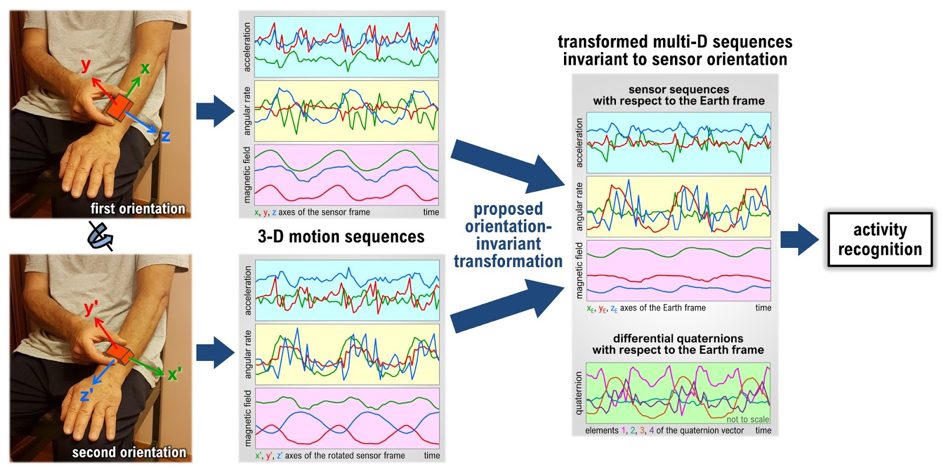
Sensing, information processing, and communications are the three essential components of information technology. Among these, sensing has gained significance in recent years and besides applications in industry and automation, it is increasingly involved and integrated into everyday commercial (consumer) products. With rapidly developing technology, devices such as tablets, smart phones, smart watches and rings have made their way into our daily lives. It is now becoming essential for such devices to recognize and interpret human behavior correctly in real time.
Context-aware systems or system components possess the capability of analyzing information/data about their environment to make behavioral changes in order to adapt to the environment. To develop such context-aware systems, sensors with different physical characteristics that have complementary nature play an important role. As a consequence of the rapid development (advances) in micro electro- mechanical systems (MEMS) technology, pervasiveness of sensor technology and wireless communications, the size, weight, and cost of commercially available motion sensors have decreased considerably over the last two decades. Among these are accelerometers, gyroscopes, and tilt sensors. These devices have gained wireless transmission capabilities, and been integrated into mobile devices and accessories such as smart phones, watches, bracelets, and rings.
The use of wearable motion sensors, with their low hardware and software requirements, have become a significant alternative to computer vision-based and radio frequency identification motion capture and recognition systems that rely on external sensors such as cameras or antennas.
In recent years, research has intensified in the field of recognition, monitoring and differentiation of human activities. Acquiring information about a user’s activities for ambient-assisted living in smart homes and detecting the situations requiring emergency intervention such as falling and injury, without delay, to assist the elderly or people with special needs are challenging research issues highly regarded and supported by the European Union. Movement recognition and classification methods are used to monitor the healing processes of patients who live alone and who need support in their daily lives in their own homes, to follow the recovery processes of patients who undergo physical rehabilitation after the operations they have undergone, and to perform physiotherapy sessions at home without the need to go to the hospital. However, automatic monitoring of people performing daily activities should be done without restricting their independence, intruding on their privacy, or degrading their quality of life. These systems aim to maintain the user’s independence, enhancing their personal safety and comfort and delaying the process of moving to a care home.
There exists approaches in two broad categories to recognize daily activities and unusual but dangerous events such as falls. A commonly used approach is designing smart environments through the use of one or more types of sensors in a complementary fashion (e.g., cameras, acoustic, and tactile sensors). This approach, besides its disadvantages such as relatively high installation cost and heavy demands on computing power, restricts the independence and mobility of the person to the monitored environment. Wearing the sensors on the body is the second alternative which is highly favored because wearable sensors can be used both indoors and outdoors, have low computational requirements, and do not invade the privacy of the user. Recent work on automatically recognizing daily activities has focused on machine learning algorithms that rely on simultaneous input from several different sensor modalities such as visual, inertial, acoustic, force, pressure, strain, physiological, and kinetic sensors, among others. Supervised and unsupervised learning allows making more reliable decisions about the activity type.
Some significant potential applications of wearable sensing are home-based rehabilitation, physical therapy, bio-mechanics, ergonomics, motion training in sports and dance, animation and film making, virtual reality, among many others. Activity recognition with wearables also has various potential applications in the healthcare domain in the form of medical state monitoring, memory enhancement, medical data access, and emergency communications. Applications such as measuring the energy expenditure of the human body, fall detection and classification, and gait analysis are among those that aim to improve the quality-of-life of the user.
Sample Publications:
B. Barshan, A. Yurtman, “Classifying daily and sports activities invariantly to the positioning of wearable motion sensor units,” IEEE Internet of Things Journal, 7(6):4801-4815, June 2020.
A. Yurtman, B. Barshan, “Novel non-iterative orientation estimation for wearable motion sensor units acquiring accelerometer, gyroscope, and magnetometer measurements,” IEEE Transactions on Instrumentation and Measurement, 69(6):3206-3215, June 2020.
A. Yurtman, B. Barshan, B. Fidan, “Activity recognition invariant to wearable sensor orientation using differential rotational transformations represented by quaternions,” Sensors (MDPI), 18(8), article no: 2725, August 2018, Special Issue on Data Analytics and Applications of Wearable Sensors in Healthcare.
I. Umay, B. Fidan, B. Barshan, “Localization and tracking of implantable biomedical sensors,” Sensors (MDPI), 17(3), article no: 583, March 2017.
A. T. Özdemir and B. Barshan, “Detecting falls with wearable sensors using machine learning techniques,” Sensors (MDPI), 14(6):10691-10708, 18 June 2014.
K. Altun, B. Barshan, O. Tunçel, “Comparative study on classifying human activities with miniature inertial and magnetic sensors,” Pattern Recognition, 43(10):3605-3620, October 2010.